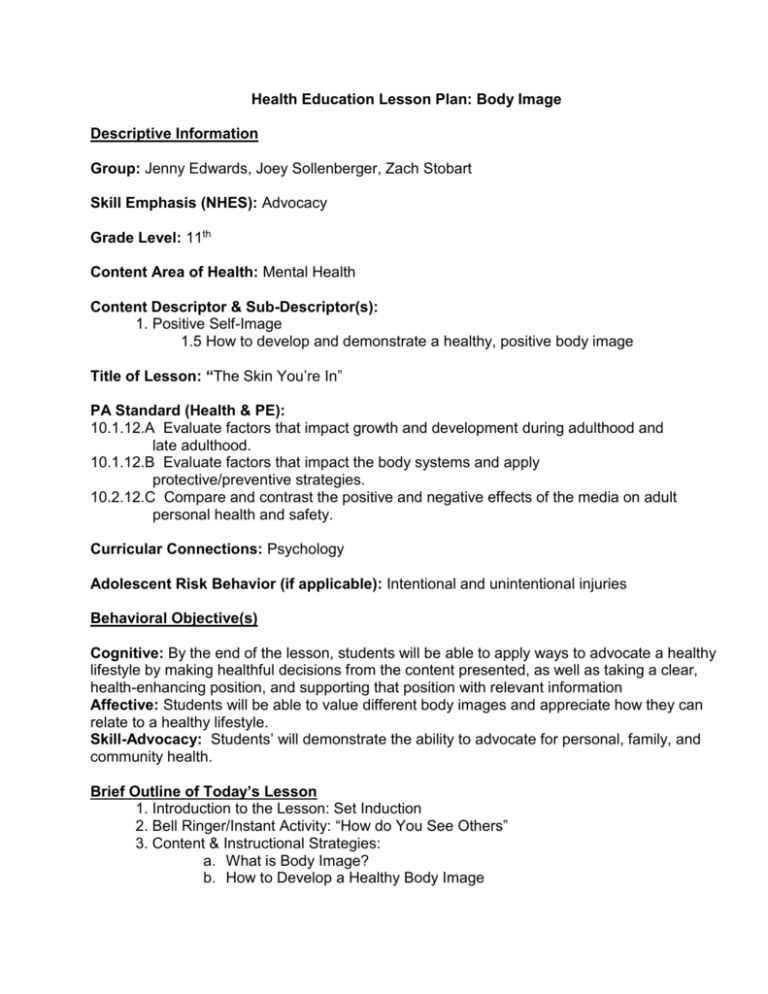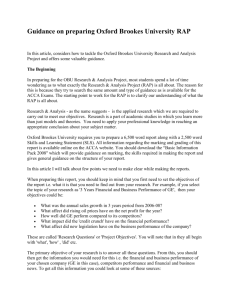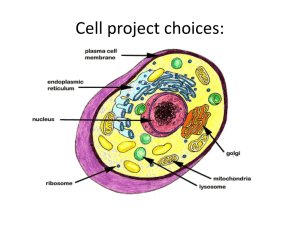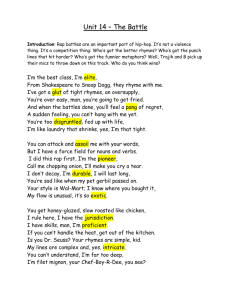Health Education Lesson Plan: Body Image
advertisement

Health Education Lesson Plan: Body Image Descriptive Information Group: Jenny Edwards, Joey Sollenberger, Zach Stobart Skill Emphasis (NHES): Advocacy Grade Level: 11th Content Area of Health: Mental Health Content Descriptor & Sub-Descriptor(s): 1. Positive Self-Image 1.5 How to develop and demonstrate a healthy, positive body image Title of Lesson: “The Skin You’re In” PA Standard (Health & PE): 10.1.12.A Evaluate factors that impact growth and development during adulthood and late adulthood. 10.1.12.B Evaluate factors that impact the body systems and apply protective/preventive strategies. 10.2.12.C Compare and contrast the positive and negative effects of the media on adult personal health and safety. Curricular Connections: Psychology Adolescent Risk Behavior (if applicable): Intentional and unintentional injuries Behavioral Objective(s) Cognitive: By the end of the lesson, students will be able to apply ways to advocate a healthy lifestyle by making healthful decisions from the content presented, as well as taking a clear, health-enhancing position, and supporting that position with relevant information Affective: Students will be able to value different body images and appreciate how they can relate to a healthy lifestyle. Skill-Advocacy: Students’ will demonstrate the ability to advocate for personal, family, and community health. Brief Outline of Today’s Lesson 1. Introduction to the Lesson: Set Induction 2. Bell Ringer/Instant Activity: “How do You See Others” 3. Content & Instructional Strategies: a. What is Body Image? b. How to Develop a Healthy Body Image c. Be an Advocate 4. Learning Activity 5. Assessment a. Core Concepts b. Advocacy c. Additional Criteria 6. Final Thoughts/Conclusion Expanded Outline of Today’s Lesson 1. Introduction to the Lesson/Set Induction: I'm fat. I'm too skinny. I'd be happy if I were taller, shorter, had curly hair, straight hair, a smaller nose, bigger muscles, longer legs, flatter stomach. Do any of these statements sound familiar? Are you used to putting yourself down? If so, you're not alone. As a teen, you're going through a ton of changes in your body. And as your body changes, so does your image of yourself. Lots of people have trouble adjusting, and this can affect their self-esteem. There are tons of outside influences affecting how you perceive your body, and you may not even realize it! It is so important to be comfortable with who you are, and the body you are in, so that you can help others be comfortable in their skin! 2. Bell Ringer (Instant Activity): How Do You See Others? (5 min.) Each student will receive a notecard and a piece of tape. The notecard will be taped to back of every student. They must go around to 3 or 4 individual students and write a positive comment about that person. After they have seen 4 people, they can remove the notecard and look at the positive comments they received. Students should not choose who they would like to make comments about. During this brief activity the three of us will monitor the students closely so no one is writing inappropriate comments. We will make a personal tally of how many of their comments refer to something that they like about the person’s “outer” self (eyes, hair, clothes, etc.) and how many comments refer to the person’s “inner” self (personality, morals, etc.). The results of the tally will then be shared with the class to stimulate a short discussion. o What is usually the first thing that you notice about someone? o Do you care about how others see you? 3. Content & Instructional Strategies: Content Outline: I. What is Body Image? (PowerPoint Lecture) a. Body image is how someone feels about his or her own physical appearance. It is linked closely to self-esteem because as you develop into teens you care more about how others see you. b. Some aspects of body images include mental and physical appearances. You mood and emotions can affect the way you see yourself. If you don’t think you look good in a certain outfit on a particular day then you are more likely to be unhappy with your appearance. c. Develop a strong perceptive of yourself. Know who you are and not worry about what others may think of you. II. Different Body Types a. Endomorph (short and wide) i. Shorter build with thicker body parts,, gain fat easier b. Ectomorph (tall and thin) i. Light build with smaller joints and lean muscle and long, thin limbs c. Mesomorph (muscular) i. Large bone structure with large muscles and a naturally athletic physique III. Male Vs. Female Image Issues a. Male issues: i. Being tough, looking “macho,” having big muscles, being athletic/competitive. b. Female stereotypes: i. Being thin and tall, having big boobs and a butt, being tan, and having great hair a. YouTube Video “TEEN TRUTH: BODY IMAGE” IV. What Influences Our Self-Esteem/Body Image Students will be broken up into groups and given white boards to write down as many influences that affect body image. Students will share their responses as we record them on the board. a. Media b. Family and Friends c. Peers - The media portrays woman and men as gaunt and very thin figures. Making the norm of society to look as those models do. o YouTube Video: Dove- Evolution Commercial http://www.youtube.com/watch?v=hibyAJOSW8U&feature=related This video represents the media’s distortion of body image. Ask for brief feedback on what they just saw. V. Advocacy a. Explain Advocacy i. Take a Stand - What’s important to you? ii. Support your Position – Accurate information, be assertive iii. Know your Audience – Respect others opinions iv. Encourages other to make healthful choices a. Advocacy can be done for your own needs or on the behalf of others. i. Focus on their attributes. b. Example: Media Advocacy – If see a commercial or television ad that upsets you how could you advocate positive body image through the use of media? i. Post an ad in the local Newspaper ii. Write a letter to the ad company VI. Be an Advocate for Yourself a. Three A’s: Attention, Appreciation, and Acceptance. i. Attention is listening to your internal cues, ii. Appreciation is enjoying the pleasure your body can provide you. iii. Acceptance is being able to accept what is, instead of longing for what is not. b. What you can do i. Stay Positive to self and others a. Fight size discrimination by refusing to speak negatively of others and don’t let every new inch or curve upset you, instead, work on focusing your thoughts and energy toward the unique and amazing person you are rather than what you believe you are not. ii. Stay Healthy a. Diet and daily physical activity iii. Arrange Priorities a. Think what is important to you 4. In Class Learning Activity: “Rap Melody” (Skill to be Practice – Advocacy) - - - In this activity students are in groups of 4 and will be asked to make a rap presentation on positive body image. o Why you love your body Students will be given ample amount of time to come up with an 8 or more line rap that includes two facts on being an advocate for positive body image. o The rap can be set to music or freestyle. Groups will have the choice to either select a student to present or the group may present together. At the beginning of the activity, a rubric will be handed out so the students know what criteria should be included. o Remember to have fun and enjoy your time rapping about loving the skin you are in. o Students will have a beat from the web to go alone with their rap. 5. In-Class Learning Activity Assessment-Description & Criteria - An analytical rubric will be used to assess the in class activity; Rap melody. It will be used for assessing the criteria and content the students used within the rap itself. The rubric will score the content and accuracy of the information as well as comprehensiveness. The length of the rap will also be scored. Students must have at least 8 lines in order to receive a high score. Advocacy is the NHES skill, so students are expected to incorporate ways to help and advocate others on positive body image. Make sure students are being creative and unique as this is one of the areas they will be assessed on. Lastly, students who show a positive attitude and enthusiasm will receive a good score too because again this is another area students will be assessed. - Score the “Rap Melody” activity using the following format of core concepts, skills, and other criteria. Core Concepts: - Content for positive body image o Information is clear and accurate o Comprehensiveness o Conclusions are drawn o Relationships among concepts are shown Skill: Advocacy: - Takes a clear, health-enhancing stand/position - Supports the position with relevant information - Shows awareness of audience - Encourages others to make healthful choices - Demonstrates passion and conviction Additional Criteria: - 8 lines or more are present - The rap is creative and unique - Completed the questionnaire (Rap reflection) - Displays a positive attitude and enthusiasm. 6. Final Thoughts / Conclusion to the Lesson Checking for Understanding: (Verbal) - What are some healthy ways to maintain a positive body image? How might you advocate for others on body image. In today’s lesson we discuss what Body image is and issues that surround both men and women when it comes to a positive and healthy body image. We need to educate ourselves as well as others on the pressing issues that surround our young teenage population. Also, topics like, how to love your body and how to advocate for other were discussed. Other areas such as outside influences and different body types were also mentioned in today’s lesson. Many young teenage girls suffer the most from issues that surround body images. The videos we watched earlier today depict how the majority of photos and billboards you see are transformed into what we want to see rather than what is actually there. It’s surprising that so many women want to look like the models they see in magazines and pictures, but little do they know what they are seeing really do not exist. 7. Classroom Management & Materials Classroom Materials o Handouts/worksheets: Rap Packet – Contains the activity directions, reflection assessment, fact sheet; Grading Assessment Form; Analytical rubric. o Other Material: White Boards, markers, notecards, tape, music (optional) scrap paper, pen or pencil Classroom Management o For Content Delivery: Traditional classroom seating or assign seating will be in affect during the content delivery. o For the in class assignment, students will be in groups of 3 or 4. Content References: CCSSO-SCASS Health Education Assessment Project (2006). Assessment Tools for School Health Education, ToucanEd Inc. Santa Cruz, CA Lyness, D. (2009, May 3). Body image and self esteem. Retrieved from http://kidshealth.org/teen/your_mind/body_image/body_image.html# Thompson, J.K. (1999, November 2). The Media’s Influence on Body Image Disturbance and Easting Disorders: We reviled them, Now We Can Rehabilitate Them. Retrieved from: http://jkthompson.myweb.usf.edu/articles/The%20Media%27s%20Influence%20on%20 Body%20Image%20Disturbance.pdf TCU Counseling, Testing and Mental Health Center. (2004). Myths and Facts About Body Image. Retrieved from: http://www.counseling.tcu.edu/myths_and_facts_about_body_image.asp Dove Evolution Commercial. Youtube.com http://www.youtube.com/watch?v=hibyAJOSW8U&feature=related Teen Truth: Body Image PSA. Youtube.com. http://www.youtube.com/watch?v=PpFBKeuKf7M Appendices: “Recap with a Rap” DIRECTIONS: You and your group members must come up with a rap that advocates for positive body image. Take the information you learned through today’s lessons and write a rap that includes at least 8 or more lines. You have to include two facts within the rap. Choose one group member to perform it in front of the class, or you may decide to perform as a whole group. Remember to be creative and have fun with it. You may choose you freestyle or put to music. Group Members Names: Title: ___________________________________________________________________________ ___________________________________________________________________________ ___________________________________________________________________________ ___________________________________________________________________________ ___________________________________________________________________________ ___________________________________________________________________________ ___________________________________________________________________________ ___________________________________________________________________________ ___________________________________________________________________________ ___________________________________________________________________________ ___________________________________________________________________________ ___________________________________________________________________________ ___________________________________________________________________________ ___________________________________________________________________________ ___________________________________________________________________________ ___________________________________________________________________________ ___________________________________________________________________________ _________________________________________________________________________ Grading Assessment Form “Rap Melody” ______/4 points Content (Core Concepts) Accurate and Comprehensiveness ______/4 points Advocacy (NHES Skill) ______/4 points Length of Oral Presentation ______/4 points Creativity/Uniqueness ______/4 points Positive Attitude and Enthusiasm ______/4 points Rap Reflection ______/24 points TOTAL RAP REFLECTION Name_____________________________ Date_________________ Complete the following questions pertaining to the in class activity. 1. Why did your group choose the two specific facts to incorporate into your rap masterpiece? 2. Which rap was your favorite? Give two reasons why. 3. Which line in your rap best describes your position on a healthy body image? 4. Other than an oral rap, give an example of another way to promote advocacy towards a healthy body image. Analytical Scoring Rubric Parameter 4 3 2 0-1 Content (Core Concepts) The response is complex, accurate, comprehensive, showing breadth & depth of information. The response contains at least 2 facts from the content slides. The response identifies relationships between 2 or more health concepts; there is some breadth of information, has 2 facts, although there may be minor inaccuracies The response shows some accurate information about the relationships between health concepts, but the response is incomplete and there are some inaccuracies. The response has less than 2 facts from the content. The response addresses the assigned task but provides little or no accurate information about the relationships between health concepts. The response doesn’t contain any facts from the content. Advocacy (NHES/Skill) The response shows evidence of the ability to apply advocacy skills; the response is complete and shows proficiency in the skill. The oral presentation has at least 8 or more lines. Presentation is creative and unique The response shows evidence of the ability to apply advocacy skills; the response is mostly complete but may not be fully proficient. The oral presentation has 5 -7 lines Presentation is unique, but creativity could be improved The response shows little or no evidence of the ability to apply advocacy skills. Students demonstrate a positive attitude and show an abundance of enthusiasm during the rap. All 4 questions are completed fully and accurate. Students demonstrate a positive attitude but enthusiasm could be improved. 4 questions are completed but answers are vague. The response shows some evidence of the ability to apply advocacy skills; the response may have inaccuracies or be incomplete. The oral presentation has 3-4 lines Presentation is somewhat unique or creative, but both could be improved Students demonstrate a somewhat positive attitude and enthusiasm can be improved 3 questions are completed with little information. Length of Oral Presentation of Rap Creativity & Uniqueness Positive Attitude/Enthusiasm Rap Reflection The oral presentation has 1-2 lines Presentation is bland; no creativity or uniqueness Students show no signs of a positive attitude and enthusiasm toward the rap is not seen. 0-2 questions completed; not in sentence form. 8. 9. 10. 11. 12. 13. 14. 15. 1. At any point in time, 40-50% of American women are trying to lose weight. 2. In 2008, men accounted for 20% of all plastic surgeries 3. The average American woman is 5’4” tall and weighs 140 pounds. The average American model is 5’11” tall and weighs 117 pounds. 4. Men make up 10% of anorexics and 20% of bulimics. 5. One out of every four college-aged women have an eating disorder 6. Eight million Americans are being treated for eating disorders, 7 million are female and 1 million are male. 7. Americans spend more than 40 billion dollars a year on dieting and diet-related products – that’s roughly equivalent to the amount the U.S. Federal Government spends on education each year! Almost half of all women smokers smoke because they see it as the best way to control their weight. Of these women, 25% will die of a disease caused by smoking. A study found that 53% of thirteen-year-old American girls are unhappy with their bodies. This number grows to 78% by the time girls reach seventeen. It has been estimated that young women see more images of beautiful women in one day than their mothers saw through their entire adolescence About one million American men have tried steroids once; up to 6 percent have taken them by age 18. 80% of children who are ten years old are afraid of being fat. A 1996 study found that the amount of time an adolescent watches soaps, movies and music videos is associated with their degree of body dissatisfaction and desire to be thin. One in every three (37%) articles in leading teen girl magazines also included a focus on appearance, and most of the advertisements (50%) used an appeal to beauty to sell their products. In a survey of adolescents in grades 7-12, 30% of girls and 25% of boys reported teasing by peers about their weight Myth: Overweight people are ugly. Fact: Beauty is a learned concept, and the cultural norm of beauty changes over time. At the turn of the century, the leading sex symbol, Lillian Russell, weighed over 200 pounds. Marilyn Monroe would be considered "overweight" today. The media, advertisers, and the diet industry tend to set the standard of beauty in today's society. We must remember that they are selling us dissatisfaction with our bodies in order to make a profit. Myth: You have to exercise a lot for it to do any good. Fact: There are big health benefits in accumulating 30 minutes of moderate activity on most days (ten minutes three times a day equals 30 minutes!). But any movement is better than no movement. You could start with a five-minute walk today and build up from there. Myth: Overweight people are lazy. Fact: Different people have different bodies. Sure, there might be some lazy fat people, but there are also plenty of lazy thin people. All of our bodies have a different natural baseline size and while food intake and exercise may contribute to changing this some, there are also many other factors involved that can't be controlled, such as metabolism, bone structure and genetics. Just because someone is fat does not mean they are anymore lazy than someone who is thinner. Myth: Eating disorders are a woman's problem. Fact: Eating disorders affect many people regardless of sex, gender identity, race, ethnicity, age, class or sexual orientation. All types of eating disorders affect men as well as women, including anorexia, bulimia, compulsive overeating, and overexercise. Due to the myth that eating disorders don't affect men, fewer men who have eating disorders have actually been labeled as such. Most figures say that about 10% of people with eating disorders in the U.S. are men, though even this number may be low. Myth: I want to look like a magazine model in real life. Fact: You may want to look like a model, but it's important to understand that even models don't look like their pictures in real life. There are many tricks to "doctoring" pictures. Some techniques include airbrushing, computer alterations, special lighting to cast shadows in just the right places, or even black and white photography, especially on "muscular" men so that the definition of muscles is greater. All types of media trick us into thinking that there are people who look far more "perfect" than any person really ever does. Myth: If I hate my body, there is nothing I can do about it. Fact: There may be little you can do to change the body you have, but there are many things you can do to change your way of thinking about your body. To build your body-confidence, try new activities and find things that your body is good at doing. For every negative thought you have about your body come up with a positive one to counter it. Try not to break your body down into parts, but rather think of it as a whole, functional unit.







